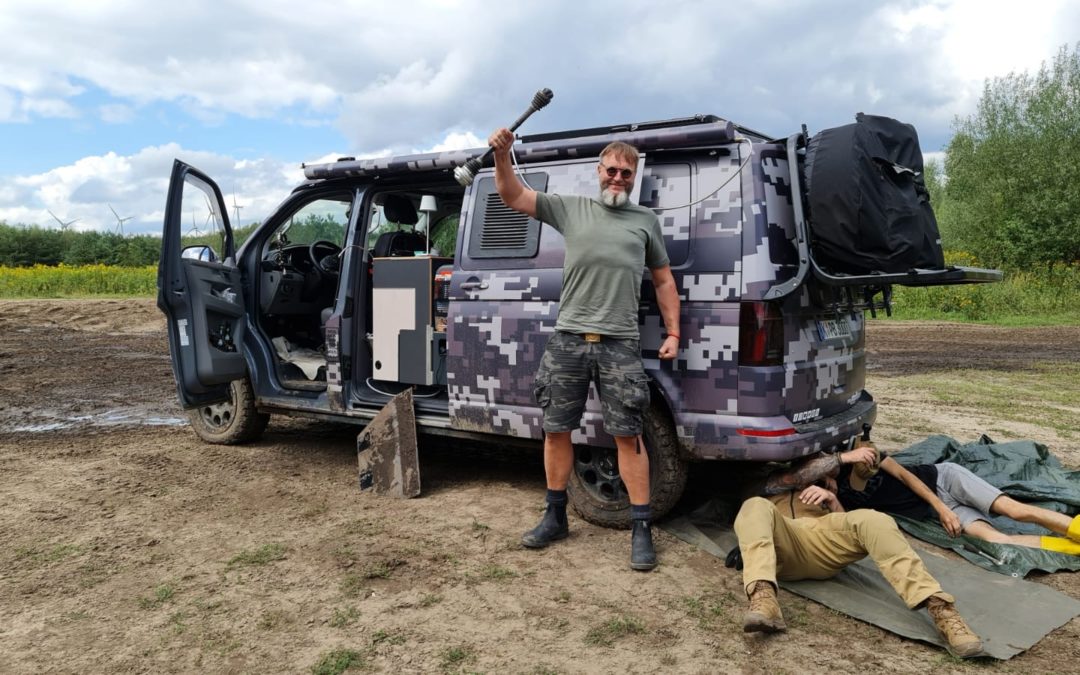


The first destination of our long journey lies north of the town of Fürstenau. Here, close to the German-Dutch border, is the largest outdoor area in Europe - the Fursten Forest. A 400-hectare former training ground of the German army has been put to peaceful use. But what brings us here? Axel Fröhlich from the 4x4training.com has invited you to overlanding driver training. This training course, which is tailored to off-road buses, offers the opportunity to explore your vehicle and its limits.
When we arrive on Friday evening, the first person we bump into is @nurmalkurzraus. We already 'know' him and his Seikel VW T5 from his Instagram account. We hit it off from the very first moment. It soon becomes clear that we have a lot in common, both privately and professionally. Maybe that's why. We are soon joined by other buses. In addition to several VW T5s and T6s and two VW Crafters, there is also an older Ford. What they all have in common is not only that they want to gain off-road experience, but also that they are relaxed and extremely friendly. The next morning Axel joins us in a VW Touareg and his partner Helmut in a Lada Niva. - So we are ready to go.



Moderate to difficult terrain awaits us in Fursten Forest. We want to concentrate on the medium difficulty. Due to its size, the area offers plenty of opportunities to get lost. There are various new facilities for four-wheel drivers and other off-road riders, such as a bridge, a seesaw, cross axles and a winch. We only take a look at the latter. If you want to dismantle your van, you can do so here. We first drive to an old sand quarry. This is the perfect place to simulate driving in the desert. We quickly discover the limits of our vehicles. Sand plates and shovels are used for the first time. However, this also shows that it makes sense to invest in reinforced towing eyes "recovery eyes" for all those who want to move their vehicle off the road. As recovery or self-recovery is an integral part of the training, shovels, ropes, recovery straps, sand plates, compressors and jacks had to be packed in advance.
The latter appeared in the next step. "Please change a wheel" came the kind request. This sometimes led to long faces. Because the original jack doesn't work out here due to the low height and load capacity. We had decided in advance to use a hydraulic telescopic jack that could lift up to 5000 kg. That would have been enough. But it was more about pointing out the potential problems than unnecessary work. - We were lucky. It was warm enough for one or two of us.



Next came Forst Durchfahrten, the ground was partly sandy and partly clayey. Various water holes offered the opportunity to sink the bus. A good opportunity to raise awareness of the dangers. A stick quickly shows how deep a "small" puddle can be. In this way, we learn to avoid puddles and mud better. But sometimes you just have to go through them. This makes it all the more important to clean the van afterwards. Mud splashes may look cool, but mud deposits in the V-belt or underbody are not.
Armored hills allow you to learn how to drive over crests. This is only possible by crossing them in order to reduce the wheelbase and ensure that as many tires as possible are in contact with the ground. This usually works, but not always. - But how did BUTCH fare?
Moderate to poor. - At first it did very well on forest paths, and even a muddy passage was mastered with flying colors. The seesaw was no major obstacle either. But an inclined slope broke our necks, or rather BUTCH's neck, no, a drive shaft. So it was more of a broken leg. He mastered the descent with excellence. But when it came to mastering the ascent, we were in for a rude awakening. There was a loud bang. It was immediately clear that something elementary had gone. BUTCH slowly rolled backwards down the hill. The destroyed drive shaft was removed on the spot. BUTCH then had to be pulled off the field.
At this point at the latest, I was grateful for the recovery eyelets. But I hadn't thought that the recovery training would go that far. I'm already looking forward to the discussion that the T4 is the last Bulli and only the T1, T2 or T3 are actually any good. Yes, today we are also "somewhat" depressed. And my understanding of VW hit rock bottom when they said they weren't sure if and when a drive shaft could be delivered. But what is the alternative? Sell the BUTCH to switch to a T3? Certainly not. Because all the other T5s and T6s have done well. And although many people, including us, like the T1 to T3, there are apparently only a few who are prepared to go on a long tour in it and live in it. Space is too limited and comfort is even more limited. Much more often we have seen beautifully restored Bullis on the road, which have a stylish camping interior, but whose driver goes to a hostel or hotel in the evening. Or the T3, which is parked at the campsite but pulls a quad bike for off-road driving. - Not a real alternative for us.
Maybe it was the driver? - Axel, our coach, says no, I did everything right. - Maybe I was just unlucky and our drive shaft had a problem right from the start. Maybe the suspension lift also had an influence, but I doubt it. - We'll now see what's in store for us and report back. The fact is, our mood is at rock bottom for now.

Even if it looks like I'm carrying the drive shaft in front of me like a sceptre, I felt more like using it as a club. What would my father have said? "You couldn't win a war with this technology" - Does anyone believe me now that he was a pacifist? - Maybe not, but I do.
Either way, I'm pretty frustrated. - But what does the world's best wife do? - She pulls out a twenty-year-old bottle of Pinot Noir S from Meyer-Näkel. "I've been saving it for a special occasion. This is certainly the right moment" - Everywhere we are is up. And if we're ever downstairs, then downstairs is upstairs. I light a cigar to go with it. If not now, then when?


Recent Comments